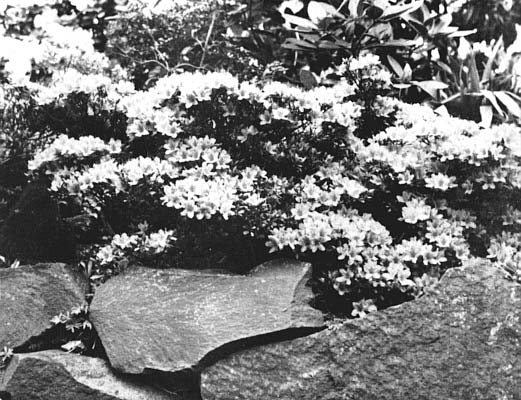QBARS - v16n4 Objective Measurement of Hardiness in Azalea
Objective Measurement of Hardiness in Azalea
Robert L. Gonderman
Los Angeles Botanical Garden, Arcadia, Calif.

|
|
Fig. 39. Kurume azalea growing on rocks
Phetteplace photo |
The lack of hardiness in plants has been a problem for mankind since plant culture began. Since with the advent of a pastoral existence, man has been plagued by the freezing and death of desirable plants. As civilization moved outward from the tropical regions, hardier plants became increasingly important for survival during adverse seasons.
The combined selective effects of both man and nature have changed several genetically plastic weeds into crop plants adapted to colder climates. The introduction of woody ornamentals has generally lagged due to lack of similarly organized production programs. Many of today's ornamental plants have been ostensibly "discovered," rather than being the result of the plant breeder's skill. In addition, testing for specific adaptive qualities has often been negligible. Most rhododendrons (and this includes azaleas as well) which have been introduced in the past have been hybridized by intelligent amateurs. More recently, professional programs, such as those of Dr. W. J. Haney of Michigan State University, have been instituted with promising results. With the ranges of desirable qualities found among the azaleas, breeders should be able to produce hardy, floriferous, compact, large flowered azaleas of intense coloration.
Several difficulties are soon found upon attempting such a program. Although all plants naturally respond dynamically to environmental stimuli, responses may vary considerably. Azaleas have long been restricted to limited ecological sites by various intolerances. To breed azaleas for adaptation to new sites, the desired characters must usually be found among individuals and recombined in the progeny. These are then tested to determine the best so that named selections may be made.
It is often desirable to add hardiness to otherwise satisfactory plants. The difficulty here lies in determining how hardy a plant is. Certainly, one cannot well look at a plant and decide upon its degree of cold hardiness.
This work was an investigation into a method to find more satisfactory methods to determine the hardiness of Azaleas without waiting for them to grow large or go through a "test" winter. Other methods used in the past have been cumbersome, time consuming, required laboratory equipment, or were non-quantitative.
After a survey of the later methods of measurement of hardiness and reviewing the controversies involved, it was decided to attempt measurements through the conductance of electricity in the plant parts.
Azaleas of a wide range of hardiness, growing in accessible locations on the Michigan State University Campus were chosen, as follows: calendulaceum , nudiflorum , poukhanense , and cultivars of 'Maxwelli Alba', 'James Gable', 'Alaska', 'Polar Bear', and 'Gloskey Pink'.
Several types of contacts were tested, finally selecting needle electrodes paired in a hand matrix. Resistances to the flow of electrons were measured in the kilo Ohm range using a multi-meter.
Two readings were necessary. One from the plant and twig in its natural state and under standard hardening conditions. The second was taken after the plant had been frozen about eighteen hours at minus eighteen degrees Fahrenheit temperature. This gave the degree of damage due to freezing as compared to the unfrozen state under hardening conditions.
The two figures were reduced to percentages and summed. Thus gave a quantitative figure which could be applied on a comparative basis to plants of unknown hardiness. Plants of known hardiness on the campus were measured every two weeks through fall, winter and spring, and standards established. As a test of the method, five hundred and fifty hybrids of unknown, but widely varying parentage were made available to the author. Most of these plants were measured, and predictions of their degree of hardiness made.
In spring, these plants were evaluated as to survival and recovery, and checked against the predictions. It was found that results corresponded closely with predictions.
This method for measurement of plant hardiness is relatively rapid, inexpensive, convenient, quantitative, and repeatable. It is confidentially expected that our ability to select especially hardy parents will result in especially hardy new varieties of azaleas. The author will apply this method to camellias at the Los Angeles Botanical Garden this fall with hopes for good results. If so, it is intended to apply the method to other genera as well.
